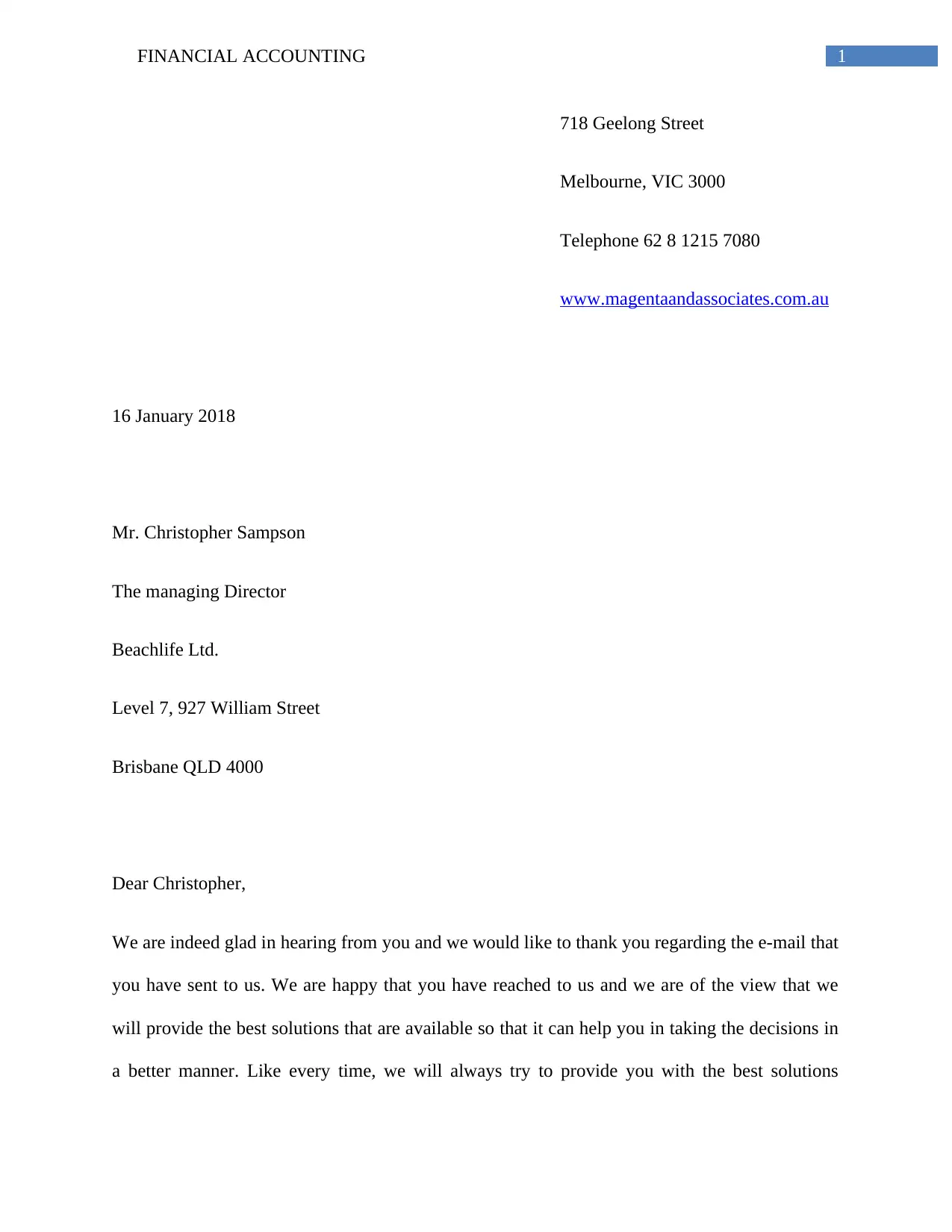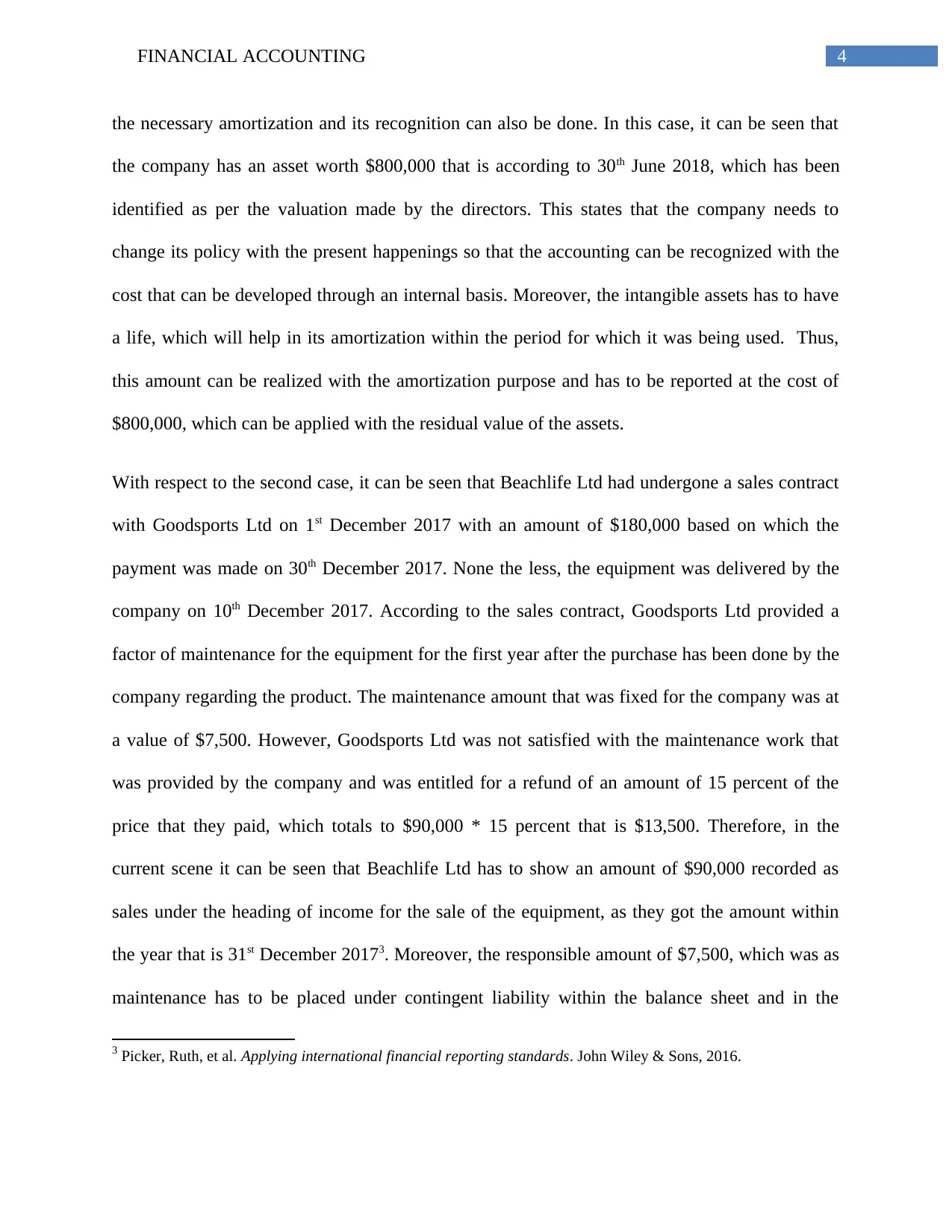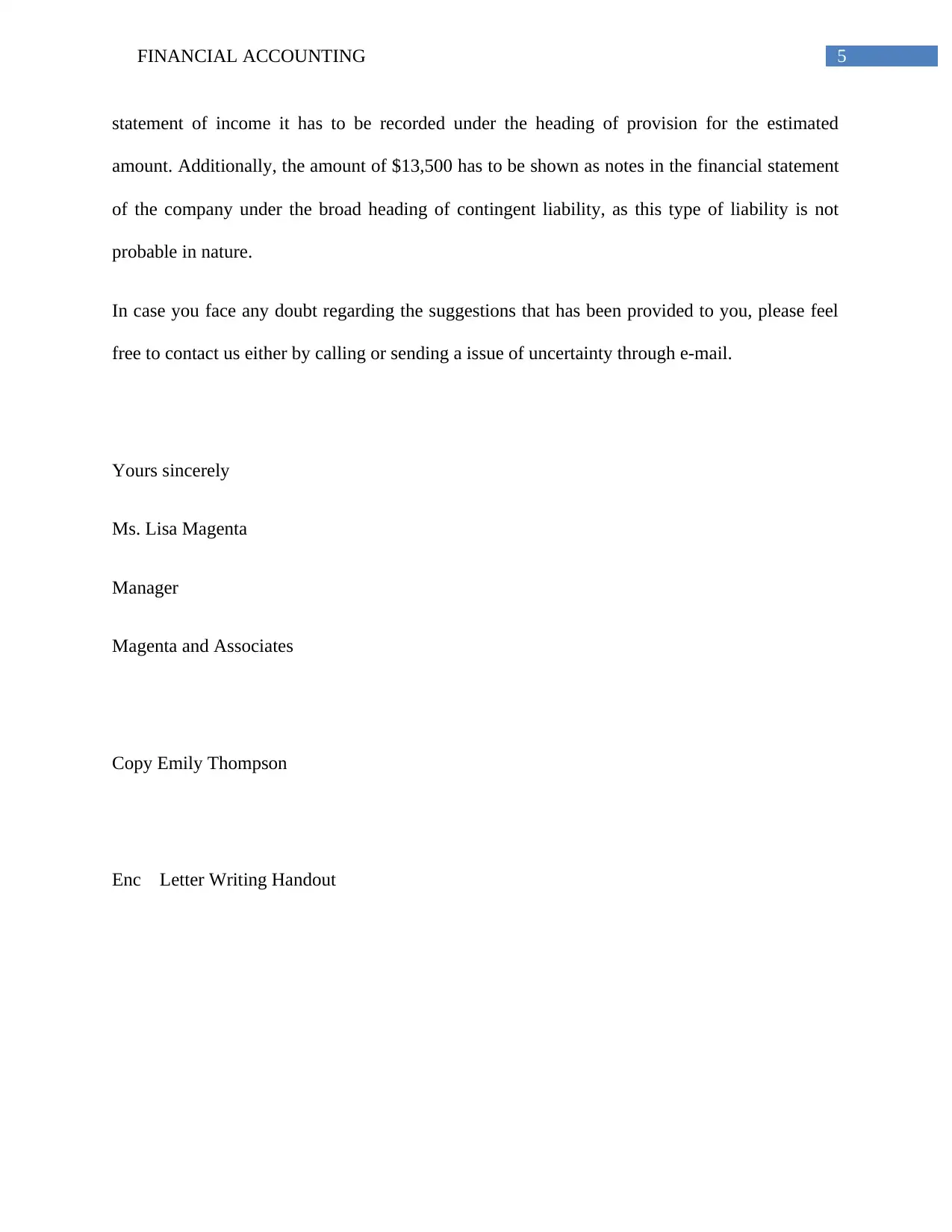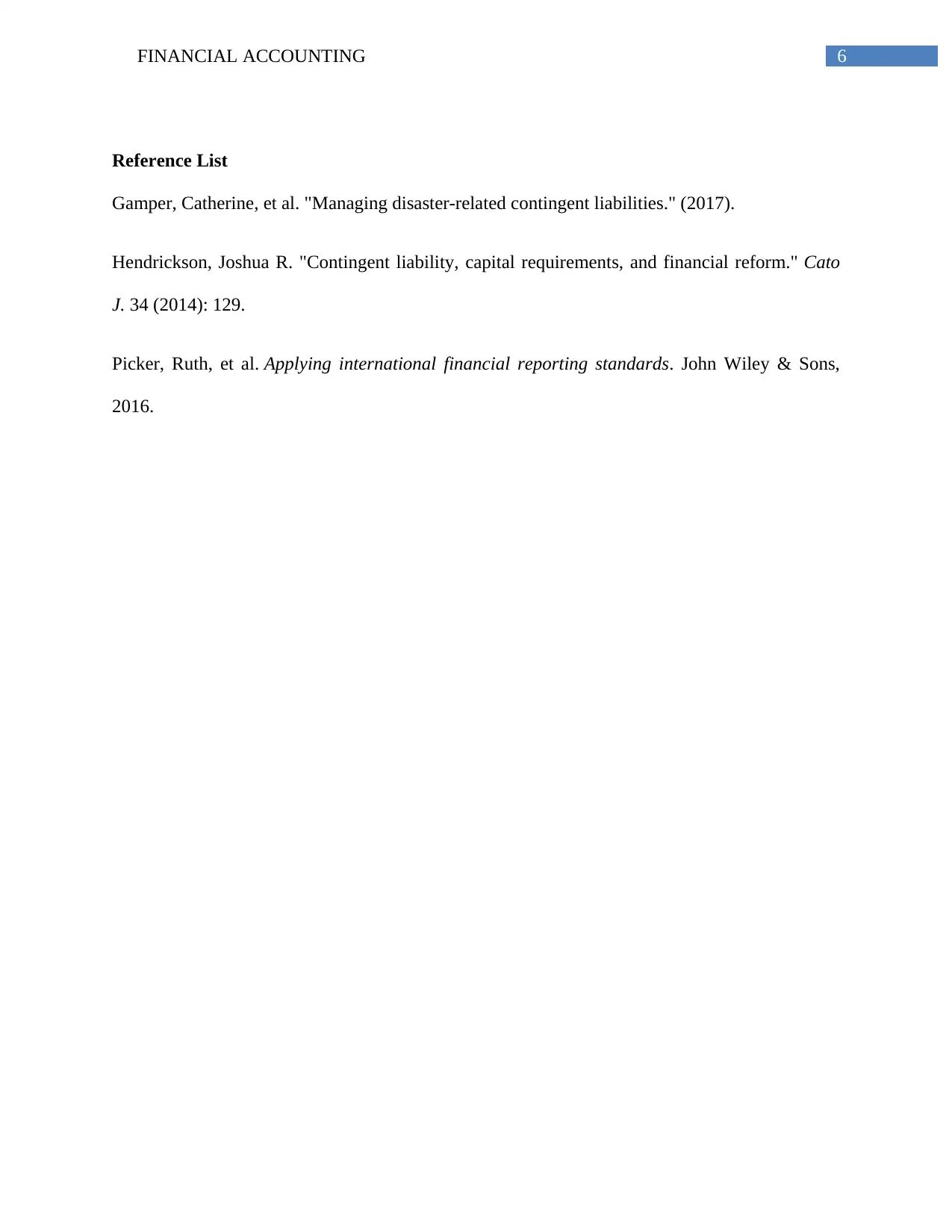Financial Accounting Report: Beachlife Ltd. and Financial Reporting
VerifiedAdded on 2020/05/16
|7
|1405
|37
Report
AI Summary
This financial accounting report, prepared for Beachlife Ltd., addresses key accounting issues including contingent liabilities, provisions, and intangible assets, in accordance with the Corporation Act 2001, AASB, and IFRS interpretations. The report analyzes the nature of contingent liabilities, referencing AASB 137, and differentiates them from provisions, highlighting their treatment in financial statements. It examines the recognition and amortization of intangible assets, based on a valuation, and assesses a sales contract with Goodsports Ltd., detailing the accounting treatment for sales revenue, maintenance provisions, and potential refunds. The report provides practical recommendations for financial reporting, emphasizing the importance of accurate financial statement presentation and compliance with accounting standards. It also gives a detailed analysis of the contingent liabilities and provisions that are present within the company, and suggests the best possible solutions for the same.

Running head: FINANCIAL ACCOUNTING
Financial Accounting
Name of the Student
Name of the University
Author Note
Financial Accounting
Name of the Student
Name of the University
Author Note
Paraphrase This Document
Need a fresh take? Get an instant paraphrase of this document with our AI Paraphraser

1FINANCIAL ACCOUNTING
718 Geelong Street
Melbourne, VIC 3000
Telephone 62 8 1215 7080
www.magentaandassociates.com.au
16 January 2018
Mr. Christopher Sampson
The managing Director
Beachlife Ltd.
Level 7, 927 William Street
Brisbane QLD 4000
Dear Christopher,
We are indeed glad in hearing from you and we would like to thank you regarding the e-mail that
you have sent to us. We are happy that you have reached to us and we are of the view that we
will provide the best solutions that are available so that it can help you in taking the decisions in
a better manner. Like every time, we will always try to provide you with the best solutions
718 Geelong Street
Melbourne, VIC 3000
Telephone 62 8 1215 7080
www.magentaandassociates.com.au
16 January 2018
Mr. Christopher Sampson
The managing Director
Beachlife Ltd.
Level 7, 927 William Street
Brisbane QLD 4000
Dear Christopher,
We are indeed glad in hearing from you and we would like to thank you regarding the e-mail that
you have sent to us. We are happy that you have reached to us and we are of the view that we
will provide the best solutions that are available so that it can help you in taking the decisions in
a better manner. Like every time, we will always try to provide you with the best solutions

2FINANCIAL ACCOUNTING
regarding the problems that are present in accounting along with the issues that you have
described within the contents of your mail and the recommendations that will be provided to you
will be in accordance with the Corporation Act 2001, AASB and its interpretations will be
according to the issues of accounting that are presented by IFRS.
You must be aware of the fact that contingent liabilities are the ones that may have potential
losses that can take place in the future may be due to the non-occurrence or the occurrence of a
specific event or due to the result of a specific outcome as well. Many examples can be cited
with respect to contingent liabilities such as the inquiries regarding some organizational failure,
which is still pending, claims that legal in nature and the warranties that are present in each
products that are purchased by the customers1. The liabilities that can be termed as contingent
needs to be shown in the financial statements of the company and the amount that has been
estimated by the company so that it can be recorded in the annual sheet. This estimated amount
can help the company to prevent the situation that may arise for them in the near future, as a
certain amount has been kept separate by them. According to AASB 137, Para 123, these
liabilities can be recognized along with the primary responsibility and the probable causes for the
outflow of the resources so that the economy of the company can be benefitted and can be settled
under these responsibilities. According to Para 29, it can be seen that jointly and severally the
liability of the company is that they have to treat these responsibilities under the broad heading
of contingent liability. These liabilities have to be developed primarily, as it cannot be expected
by the company to happen certainly during the financial year. Therefore, the analysis of these
liabilities has to be continuous so that the outflow of the resource can be determined, which will
1 Gamper, Catherine, et al. "Managing disaster-related contingent liabilities." (2017).
regarding the problems that are present in accounting along with the issues that you have
described within the contents of your mail and the recommendations that will be provided to you
will be in accordance with the Corporation Act 2001, AASB and its interpretations will be
according to the issues of accounting that are presented by IFRS.
You must be aware of the fact that contingent liabilities are the ones that may have potential
losses that can take place in the future may be due to the non-occurrence or the occurrence of a
specific event or due to the result of a specific outcome as well. Many examples can be cited
with respect to contingent liabilities such as the inquiries regarding some organizational failure,
which is still pending, claims that legal in nature and the warranties that are present in each
products that are purchased by the customers1. The liabilities that can be termed as contingent
needs to be shown in the financial statements of the company and the amount that has been
estimated by the company so that it can be recorded in the annual sheet. This estimated amount
can help the company to prevent the situation that may arise for them in the near future, as a
certain amount has been kept separate by them. According to AASB 137, Para 123, these
liabilities can be recognized along with the primary responsibility and the probable causes for the
outflow of the resources so that the economy of the company can be benefitted and can be settled
under these responsibilities. According to Para 29, it can be seen that jointly and severally the
liability of the company is that they have to treat these responsibilities under the broad heading
of contingent liability. These liabilities have to be developed primarily, as it cannot be expected
by the company to happen certainly during the financial year. Therefore, the analysis of these
liabilities has to be continuous so that the outflow of the resource can be determined, which will
1 Gamper, Catherine, et al. "Managing disaster-related contingent liabilities." (2017).
⊘ This is a preview!⊘
Do you want full access?
Subscribe today to unlock all pages.

Trusted by 1+ million students worldwide

3FINANCIAL ACCOUNTING
help in benefitting the economy of the company. On the other hand, the provision that is present
within the company has to be recognized so that the recent constructive and legal
responsibilities, which may arise from the past events, can be estimated in a proper manner and
the right amount can be kept for it. The main objective for the provision is that it has to be
adjusted with the balance of the current year in an accurate manner, which will help in taking up
the cost that belongs to the particular year and the status of finances that has been estimated can
be accounted within that particular period.
Therefore the use of provision within the company is not any form of saving, which it may seem
like in the first glance. It can be recognized generally that it comes under the balance sheet under
the heading of income statement and is placed in the bracket of expenses. Moreover, the main
difference between provision and contingent liabilities is that provisions are taken up in the
financial statements and the liabilities that can be termed as contingent are taken up under the
heading liabilities and is recorded as a note in the financial statements for the company2.
Moreover, if the probable liability is high and is expected to be around 60 percent to 90 percent,
then it has to be shown under the heading provisions within the financial statement that has been
drawn for the company. However, if the rate of liability is more than five percent and less than
60 percent, then it has to be recorded as notes in the financial statements and if the percentage is
below five then the company cannot choose to take up any action about it.
Therefore in compliance with the AASB 137 in the Provisions, Contingent Liabilities and
Contingent Assets, the first issue that has been mentioned in the email. We can provide a
suggestion that the intangible assets needs to be present in the balance sheet, which will lead to
2 Hendrickson, Joshua R. "Contingent liability, capital requirements, and financial reform." Cato J. 34 (2014): 129.
help in benefitting the economy of the company. On the other hand, the provision that is present
within the company has to be recognized so that the recent constructive and legal
responsibilities, which may arise from the past events, can be estimated in a proper manner and
the right amount can be kept for it. The main objective for the provision is that it has to be
adjusted with the balance of the current year in an accurate manner, which will help in taking up
the cost that belongs to the particular year and the status of finances that has been estimated can
be accounted within that particular period.
Therefore the use of provision within the company is not any form of saving, which it may seem
like in the first glance. It can be recognized generally that it comes under the balance sheet under
the heading of income statement and is placed in the bracket of expenses. Moreover, the main
difference between provision and contingent liabilities is that provisions are taken up in the
financial statements and the liabilities that can be termed as contingent are taken up under the
heading liabilities and is recorded as a note in the financial statements for the company2.
Moreover, if the probable liability is high and is expected to be around 60 percent to 90 percent,
then it has to be shown under the heading provisions within the financial statement that has been
drawn for the company. However, if the rate of liability is more than five percent and less than
60 percent, then it has to be recorded as notes in the financial statements and if the percentage is
below five then the company cannot choose to take up any action about it.
Therefore in compliance with the AASB 137 in the Provisions, Contingent Liabilities and
Contingent Assets, the first issue that has been mentioned in the email. We can provide a
suggestion that the intangible assets needs to be present in the balance sheet, which will lead to
2 Hendrickson, Joshua R. "Contingent liability, capital requirements, and financial reform." Cato J. 34 (2014): 129.
Paraphrase This Document
Need a fresh take? Get an instant paraphrase of this document with our AI Paraphraser

4FINANCIAL ACCOUNTING
the necessary amortization and its recognition can also be done. In this case, it can be seen that
the company has an asset worth $800,000 that is according to 30th June 2018, which has been
identified as per the valuation made by the directors. This states that the company needs to
change its policy with the present happenings so that the accounting can be recognized with the
cost that can be developed through an internal basis. Moreover, the intangible assets has to have
a life, which will help in its amortization within the period for which it was being used. Thus,
this amount can be realized with the amortization purpose and has to be reported at the cost of
$800,000, which can be applied with the residual value of the assets.
With respect to the second case, it can be seen that Beachlife Ltd had undergone a sales contract
with Goodsports Ltd on 1st December 2017 with an amount of $180,000 based on which the
payment was made on 30th December 2017. None the less, the equipment was delivered by the
company on 10th December 2017. According to the sales contract, Goodsports Ltd provided a
factor of maintenance for the equipment for the first year after the purchase has been done by the
company regarding the product. The maintenance amount that was fixed for the company was at
a value of $7,500. However, Goodsports Ltd was not satisfied with the maintenance work that
was provided by the company and was entitled for a refund of an amount of 15 percent of the
price that they paid, which totals to $90,000 * 15 percent that is $13,500. Therefore, in the
current scene it can be seen that Beachlife Ltd has to show an amount of $90,000 recorded as
sales under the heading of income for the sale of the equipment, as they got the amount within
the year that is 31st December 20173. Moreover, the responsible amount of $7,500, which was as
maintenance has to be placed under contingent liability within the balance sheet and in the
3 Picker, Ruth, et al. Applying international financial reporting standards. John Wiley & Sons, 2016.
the necessary amortization and its recognition can also be done. In this case, it can be seen that
the company has an asset worth $800,000 that is according to 30th June 2018, which has been
identified as per the valuation made by the directors. This states that the company needs to
change its policy with the present happenings so that the accounting can be recognized with the
cost that can be developed through an internal basis. Moreover, the intangible assets has to have
a life, which will help in its amortization within the period for which it was being used. Thus,
this amount can be realized with the amortization purpose and has to be reported at the cost of
$800,000, which can be applied with the residual value of the assets.
With respect to the second case, it can be seen that Beachlife Ltd had undergone a sales contract
with Goodsports Ltd on 1st December 2017 with an amount of $180,000 based on which the
payment was made on 30th December 2017. None the less, the equipment was delivered by the
company on 10th December 2017. According to the sales contract, Goodsports Ltd provided a
factor of maintenance for the equipment for the first year after the purchase has been done by the
company regarding the product. The maintenance amount that was fixed for the company was at
a value of $7,500. However, Goodsports Ltd was not satisfied with the maintenance work that
was provided by the company and was entitled for a refund of an amount of 15 percent of the
price that they paid, which totals to $90,000 * 15 percent that is $13,500. Therefore, in the
current scene it can be seen that Beachlife Ltd has to show an amount of $90,000 recorded as
sales under the heading of income for the sale of the equipment, as they got the amount within
the year that is 31st December 20173. Moreover, the responsible amount of $7,500, which was as
maintenance has to be placed under contingent liability within the balance sheet and in the
3 Picker, Ruth, et al. Applying international financial reporting standards. John Wiley & Sons, 2016.

5FINANCIAL ACCOUNTING
statement of income it has to be recorded under the heading of provision for the estimated
amount. Additionally, the amount of $13,500 has to be shown as notes in the financial statement
of the company under the broad heading of contingent liability, as this type of liability is not
probable in nature.
In case you face any doubt regarding the suggestions that has been provided to you, please feel
free to contact us either by calling or sending a issue of uncertainty through e-mail.
Yours sincerely
Ms. Lisa Magenta
Manager
Magenta and Associates
Copy Emily Thompson
Enc Letter Writing Handout
statement of income it has to be recorded under the heading of provision for the estimated
amount. Additionally, the amount of $13,500 has to be shown as notes in the financial statement
of the company under the broad heading of contingent liability, as this type of liability is not
probable in nature.
In case you face any doubt regarding the suggestions that has been provided to you, please feel
free to contact us either by calling or sending a issue of uncertainty through e-mail.
Yours sincerely
Ms. Lisa Magenta
Manager
Magenta and Associates
Copy Emily Thompson
Enc Letter Writing Handout
⊘ This is a preview!⊘
Do you want full access?
Subscribe today to unlock all pages.

Trusted by 1+ million students worldwide

6FINANCIAL ACCOUNTING
Reference List
Gamper, Catherine, et al. "Managing disaster-related contingent liabilities." (2017).
Hendrickson, Joshua R. "Contingent liability, capital requirements, and financial reform." Cato
J. 34 (2014): 129.
Picker, Ruth, et al. Applying international financial reporting standards. John Wiley & Sons,
2016.
Reference List
Gamper, Catherine, et al. "Managing disaster-related contingent liabilities." (2017).
Hendrickson, Joshua R. "Contingent liability, capital requirements, and financial reform." Cato
J. 34 (2014): 129.
Picker, Ruth, et al. Applying international financial reporting standards. John Wiley & Sons,
2016.
1 out of 7
Related Documents
Your All-in-One AI-Powered Toolkit for Academic Success.
+13062052269
info@desklib.com
Available 24*7 on WhatsApp / Email
![[object Object]](/_next/static/media/star-bottom.7253800d.svg)
Unlock your academic potential
Copyright © 2020–2025 A2Z Services. All Rights Reserved. Developed and managed by ZUCOL.





